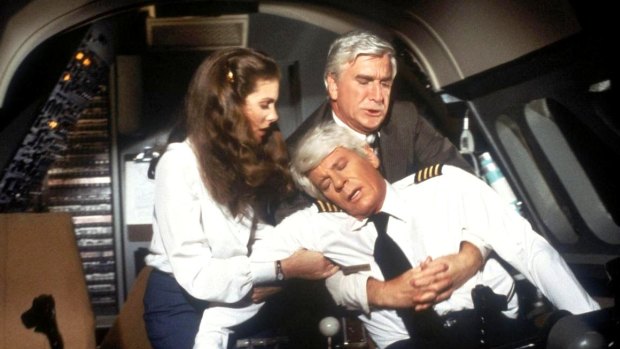This was published 7 years ago
How to land a plane without a pilot: Guide to landing a plane if the pilot dies
By Hugh Morris
"Ladies and gentleman, this is your stewardess speaking. We regret any inconvenience the sudden cabin movement might have caused, this is due to periodic air pockets we encountered, there's no reason to become alarmed, and we hope you enjoy the rest of your flight.
"By the way, is there anyone on board who knows how to fly a plane?"
For those unfamiliar, these immortal lines were uttered in the aviation spoof classic, Flying High!, a must-see for anyone who has ever flown or laughed.

Both pilots were incapacitated in 1980 comedy film Flying High!, leaving passengers to land the plane.
But joking aside, the issue of how to fly - and land - a plane when both - or all - pilots are incapacitated is an incredibly serious matter, especially for nervous passengers.
One such worrier turned to Quora, the brilliant question and answer website, for comfort. They asked: "What should I do if the pilot passes out and I (with no flight training) have to land the plane?"
See also: Pilot congratulates passengers for drinking all of the alcohol on board
The man in the know is pilot Bruno Gilissen, who responded in wonderfully detailed fashion.
"If both pilots died and no other pilot is on board and you're going to be the hero of the day, follow this procedure (for a commercial jet)," he explained.
"Don't panic [easy for him to say]. The airplane flies on autopilot. You're not dead. You're going to be the hero soon. Take your time. Following a procedure slowly produces often faster results than rushing."
Incidentally, this is not dissimilar to Flying High!, when the character played by Leslie Neilsen has to convince the traumatised fighter pilot played by Robert Hays that he can land the plane after everyone on board - including the pilots - suffer food poisoning from the fish (not the steak - and definitely not the lasagne).
Gilissen continued: "Try to find out how the radio works. This shouldn't be too hard. Don't press it yet, but there's usually a push-to-talk button on the stick, often on the backside of it, like a trigger.
"Careful here because there's also one that disconnects the autopilot on the stick… Usually the autopilot disconnect button is red and operated by a thumb."
He adds that there might also be a radio hanging "somewhere on the side", or, if in doubt, ask one of the flight attendants, assuming they're not dead, too.
Once you've found the radio, he says, press the button and call "Mayday, mayday, mayday." It's the best way to get everyone's attention. He says to explain the situation slowly.
This is when what is called a talk-down begins - when an unqualified person is assisted in flying an aircraft with radio instructions from either the ground or a nearby aircraft.
See also: What happens when some dies on a flight?
"Once you talk to someone, they'll probably try to talk you down," explains Gilissen. "They'll no doubt guide you to the nearest suitable airport that has autoland capability.
"No sweat. The airplane will land itself there, provided you operate the autopilot as you're told. You put on the autobrake and it will even brake automatically and you still get all the hero credit. Congratulations and welcome to the Tonight Show."
Well, that all seemed suspiciously easy.
However, the pilot warns that should you be unable to find someone to talk you down, you'll be faced with managing the autopilot yourself.
"This combined with the fact that you have to configure with flaps and gear as you slow down, becomes more complicated and type specific," he says.
"Flying manually, though not necessarily rocket science, should be avoided. If for some reason you end up flying manually, try to put the autopilot back on: it's there to help you and does a better job than the average type rated and qualified pilot often, so use it. Getting into autopilot modes won't happen in under two minutes, unfortunately. Neither will explaining how to do an approach and land manually."
And that's how he ends his response. So, basically, if you don't get the autopilot on you'll find yourself in a spot of bother.
Unless, of course, you are John Widley, one of the most famous successful talk-downs in history (there have not been many, mind - there is no record of a single incident like this involving a commercial jet, only a number involving light aircraft).
In 2013, the then-77-year-old landed a Cessna 172 with guidance on the radio from a flying instructor and an air traffic control manager, after the pilot collapsed in the cockpit, and later died.
Widley, who was returning to Sandtoft Airfield near Doncaster, after a day trip to Skegness, managed to land the plane "flying blind" in the dark with no lights.
"It was a controlled crash really," he told the BBC at the time.
In response to the incident, the Telegraph produced a short guide to landing a light aircraft, but it is plenty technical.
The Telegraph, London
See also: Traveller letters: Pilot's sexist comments humiliate cabin crew
See also: Unusual and record-breaking planes: Six incredible planes you'll never fly on
Listen: Flight of Fancy - the Traveller.com.au podcast with Ben Groundwater
To subscribe to the Traveller.com.au podcast Flight of Fancy on iTunes, click here.
Sign up for the Traveller newsletter
The latest travel news, tips and inspiration delivered to your inbox. Sign up now.